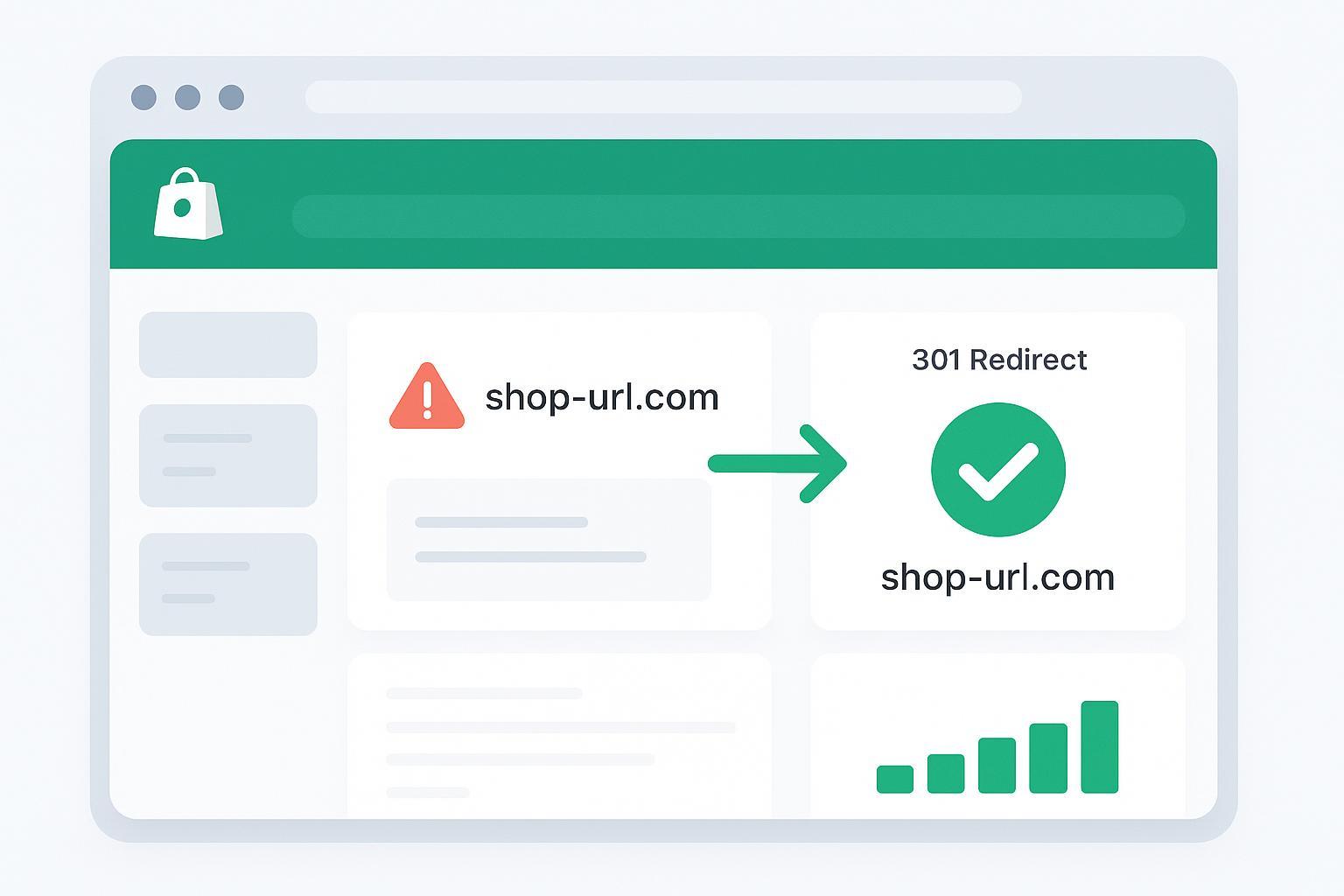How to Handle 404 Errors After Changing a URL in Shopify (2025 Best Practices)

If you’ve just changed a product, collection, or page URL in Shopify and started seeing 404s, the fix is straightforward—provided you follow a disciplined workflow. Below is the exact playbook we use on live stores to protect SEO equity and user journeys in 2025.
Rapid triage: what to do in the first 15 minutes
- Confirm whether Shopify auto-created a redirect when you changed the handle.
- Create or import 301 redirects for any missed paths.
- Validate the redirect behavior in a browser and with a header check (HTTP 301 → 200).
- Update internal links to the new URL to avoid redirect chains.
- Spot-check Google visibility with URL Inspection; plan a broader fix validation in Page indexing.
The proven workflow (Shopify-specific, 2025)
- Verify Shopify’s automatic redirect after a handle change
- Where to check: In Shopify admin, go to Online Store > Navigation > View URL redirects and look for a new rule from the old handle to the new one.
- If missing, create it manually in the next step. Shopify typically offers to auto-create a 301 when you edit a product or collection handle; you’ll see a prompt on save. This behavior is noted in Shopify’s own guidance; see the 2025 update in the Shopify SEO checklist by Shopify.
- Manually add a 301 redirect in Shopify
- Admin path: Online Store > Navigation > View URL redirects > Create URL redirect.
- Fill in Redirect from (old path, e.g., /products/old-handle) and Redirect to (new path, e.g., /products/new-handle), then Save.
- Reference for exact UI wording and CSV fields: Shopify Help Center — URL redirects.
- Bulk-fix many 404s with CSV import (fastest for >10 URLs)
- Prepare a CSV with two columns: Redirect from, Redirect to. Use relative paths for sources.
- Admin path: Online Store > Navigation > View URL redirects > Import.
- Example template:
Redirect from,Redirect to
/products/old-handle,/products/new-handle
/collections/sale,/collections/winter-sale
/pages/old-guide,/pages/new-guide
- After import, export the redirects to verify counts and spot typos.
- Tip: Keep a master spreadsheet of all redirects with dates and reasons to aid audits.
- Dev teams: create redirects via the Admin REST API
- Use the Redirects endpoint for scripted/mass operations (migrations, refactors). See Shopify Admin REST API — Redirect resource.
- Minimal POST payload:
{ "redirect": { "path": "/old", "target": "/new" } }
- Version your scripts and log every rule created/updated for rollback.
- Validate redirects and fix indexing signals in Google Search Console
- Page indexing report: Filter for Not found (404). Work through samples, fix on site (restore or redirect), then use Validate fix. See Google Search Central — Page indexing report.
- URL Inspection: Inspect the old URL to confirm Google now sees a redirect; inspect the new URL and Request indexing if the page is eligible. See Google — URL Inspection tool.
- Soft 404 check: If you served a custom 200 OK on a removed page, correct it to a 404 or 410, or redirect appropriately. Guidance: Google — Soft 404 errors.
- Update internal links and surface the new URL
- Update links in navigation menus, collections, product descriptions, blog posts, and theme sections to point directly to the new URL.
- Rebuild featured links (home page tiles, promo banners) to avoid redirect hops.
- Submit /sitemap.xml in GSC if you haven’t; Google’s Sitemaps overview explains discovery. Shopify generates a sitemap automatically.
Note on documentation and content updates: Teams often need to document URL changes and update related content quickly. QuickCreator can help draft and track these change notes alongside your SEO content workflows. Disclosure: We’re affiliated with QuickCreator.
Advanced scenarios: what changes in real stores
-
Handle change vs delete:
- Handle change: Shopify usually prompts to add a 301 from the old handle to the new one on save. Still verify the rule exists and works.
- Delete: If you delete a product/collection/page, Shopify won’t auto-redirect; you must create a redirect from the old URL to the most relevant alternative.
-
Markets and languages (e.g., /en-us/, /fr/ prefixes):
- Auto handle-change redirects may not cover every localized path. When you change a handle, validate each market-specific URL and add explicit rules as needed.
- Favor suggestion popups over auto geolocation redirects to avoid SEO and UX issues commonly seen with forced redirects; see patterns discussed by Shogun in its guide on geolocation redirects in Shopify (2025 context applies).
-
Reserved system paths:
- Some Shopify paths (like /cart and /account) aren’t redirectable in the way regular pages are. Test first; don’t rely on redirects to alter these flows. Community discussions cover these constraints; see this thread on redirecting fixed Shopify paths.
-
Domain and canonical routing:
- Set one primary domain in Settings > Domains and enable “Redirect all traffic to this domain” to avoid www vs non-www conflicts that can create confusing chains. Example cases are covered in the Shopify forums on too many redirects due to domain settings.
-
Query strings and tracking parameters:
- Native redirects may not preserve or handle parameters the way you expect. If UTM fidelity matters, test and consider an app that supports more flexible rules. A 2025 troubleshooting piece from AdNabu covers edge behaviors in Shopify redirects not working.
Troubleshooting playbooks
-
Redirect chain or loop
- Symptom: “Too many redirects” or slow page resolve.
- Fix: Point the first source directly to the final destination; remove intermediate rules. Re-test with a header check and a crawl sample.
-
Source URL still exists
- Symptom: Redirect rule doesn’t fire because the old page is still live (returns 200).
- Fix: Change the old handle or unpublish/delete, then rely on the redirect. Some behaviors are described in AdNabu’s 2025 troubleshooting linked above.
-
Trailing slash inconsistencies
- Symptom: Mixed /page and /page/ links cause duplicate rules or missed matches.
- Fix: Standardize one convention and update internal links; ensure redirect rules align.
-
Browser or CDN cache
- Symptom: You “fixed it” but still see 404s or old content.
- Fix: Hard refresh, test in incognito, or purge CDN. Then validate with curl or a header checker to confirm 301 → 200.
-
Reserved path attempts
- Symptom: Redirect rule appears saved but doesn’t fire for /cart or /account.
- Fix: Don’t attempt redirects on reserved paths; change approach (theme UX, messaging) instead.
Monitoring and regression prevention
- Weekly: Review Google Search Console’s Page indexing report, focusing on Not found (404) and Soft 404 buckets; trigger Validate fix after you address batches.
- After any major URL refactor: Run a targeted crawl of changed sections to catch chains/loops; sample with 100–500 URLs.
- Dashboards/KPIs: Track clicks and impressions for changed URLs in GSC Performance; monitor bounce and session continuity in your analytics. If redirects were applied to high-backlink pages, watch those landing pages closely.
- Documentation: Maintain a redirects log (date, path from, path to, reason). Export Shopify redirect rules after bulk work for safe keeping.
Practical snippets you can use today
- CSV template (copy/paste):
Redirect from,Redirect to
/products/old-handle,/products/new-handle
/collections/old-category,/collections/new-category
/pages/old-article,/pages/new-article
- API example (POST a single redirect):
curl -X POST \
"https://your-store.myshopify.com/admin/api/2024-04/redirects.json" \
-H "X-Shopify-Access-Token: <token>" \
-H "Content-Type: application/json" \
-d '{"redirect": {"path": "/old", "target": "/new"}}'
- Quick header check with curl:
curl -I https://yourdomain.com/products/old-handle
# Expect: HTTP/1.1 301 Moved Permanently → Location: /products/new-handle
Final checklist (print and keep)
- [ ] Confirm auto-redirect created (if handle change) and working
- [ ] Create manual or CSV-imported 301s for any missing paths
- [ ] Validate with browser + header check; fix chains/loops
- [ ] Update internal links (menus, content, theme sections)
- [ ] Inspect old and new URLs in GSC; validate fix in Page indexing
- [ ] Monitor weekly for new 404s; export and archive redirect rules
Citations and references mentioned above include Shopify’s official guidance on URL redirects, Shopify’s 2025 SEO checklist, the Redirect API resource, and Google Search Central’s docs on the Page indexing report, URL Inspection, and Soft 404 errors.

